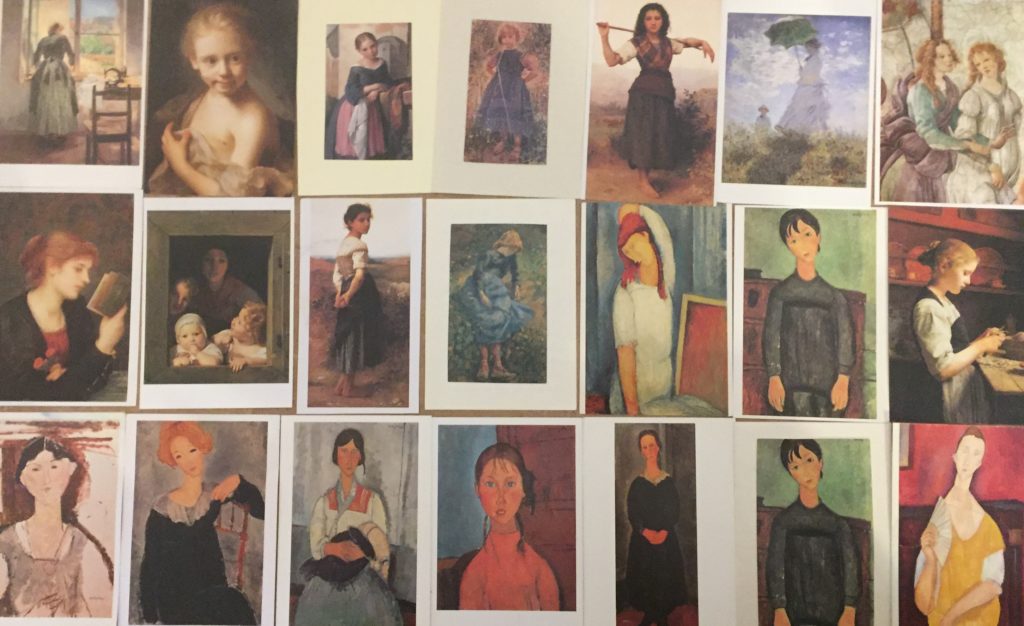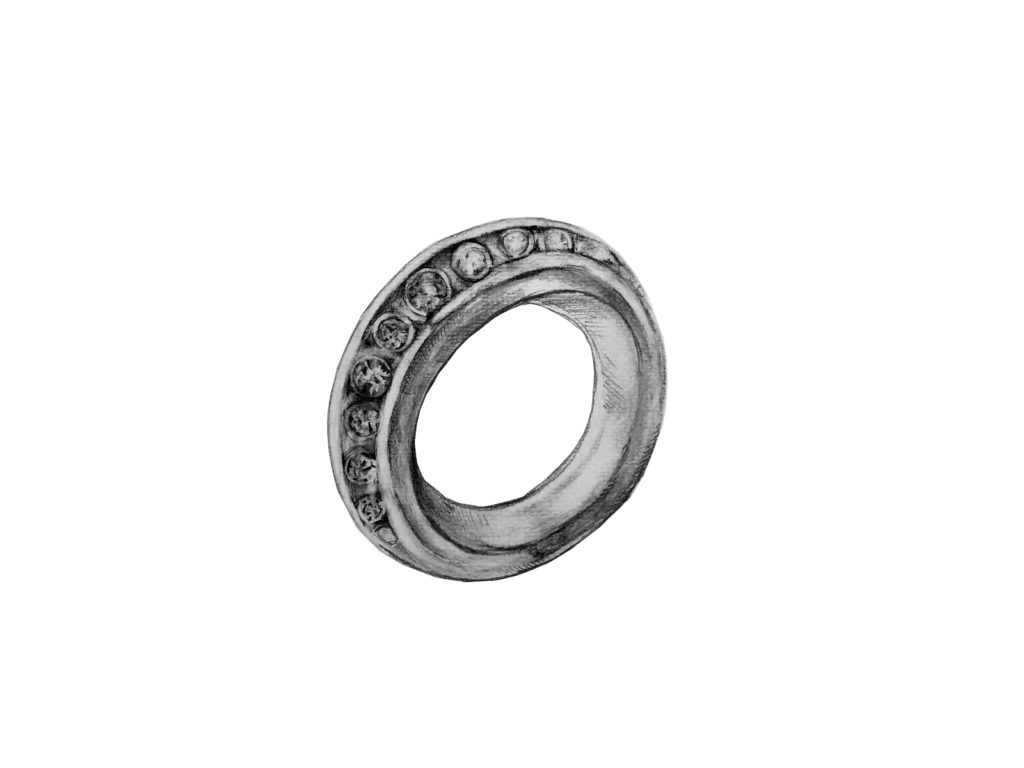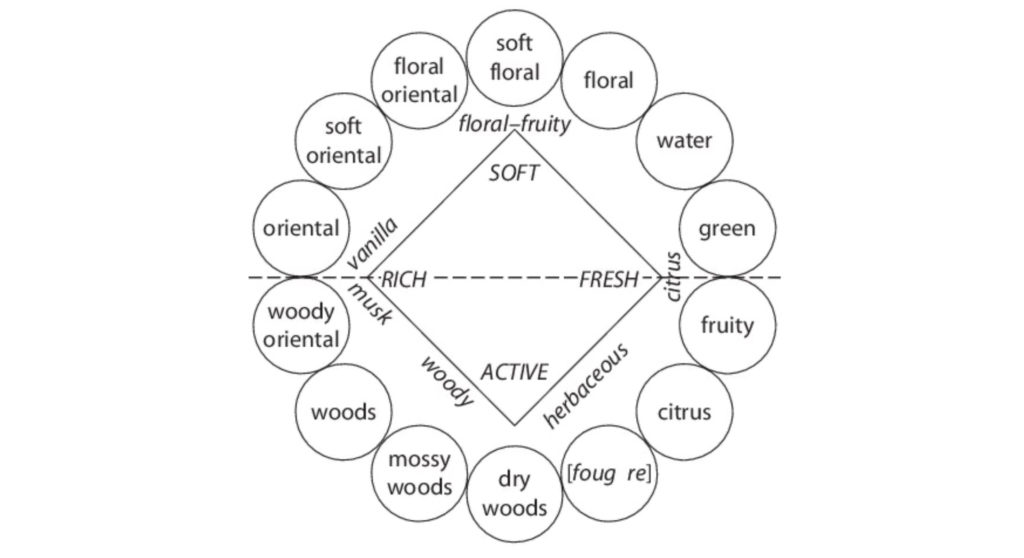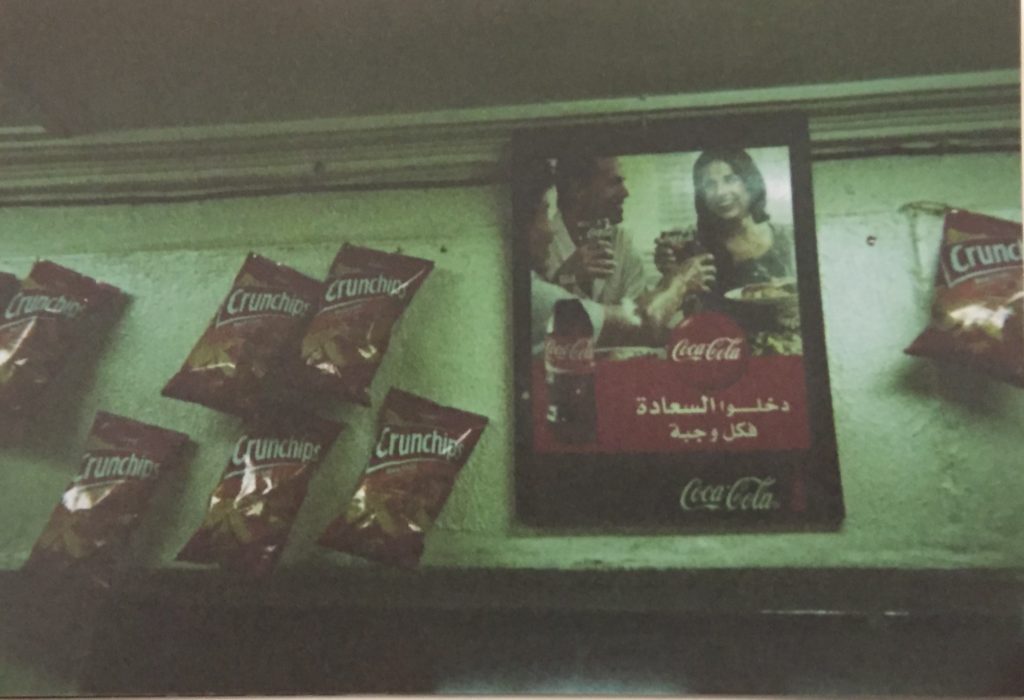
Mainstreet is Almost Alright: Repeat to Delete
Lena Appel
Exposure note zero: perforation The postcards depicting portraits of women my great uncle sent me in my youth, when I was between eight and twenty years old and he was sixty to eighty-two years old, when he died. They appear repetitively as a motive through a labyrinth. Documents of institutions that he visited throughout his […]
Exposure note zero: perforation
The postcards depicting portraits of women my great uncle sent me in my youth, when I was between eight and twenty years old and he was sixty to eighty-two years old, when he died. They appear repetitively as a motive through a labyrinth. Documents of institutions that he visited throughout his life, a map wherein, like his family would say, he’d disappear for days.
I find that in my life I organize things, mostly troublesome, unwanted or abandoned things, for other people in hindsight. I went through an archive of unpublished photos and drawings of a study from the 1960s in the Near Eastern Archeology department of the Free University in Berlin. I assisted a person who had a life-changing accident by collecting objects from the streets and ordering them in a specific manner at their home. I drew my mother’s jewelry when it got stolen to reconstruct their appearance in order to get insurance money. I went to fragrance houses to find out about the practice of a perfumer.
Jobs that were left undone. Abandonment or leaving behind plays an important role as all these collected actions need to be stripped of their meanings, exposed to their decay in my life, in order to be imaginarily reconstructed. Bataille’s “l’informe”, the process of decomposition. This act is not an act of destroying the whole figure but to keep it in tension with its antithesis, abstraction. The escape of subjecthood might start with an investigation of the subject.

Drawing of a stolen ring.
Exposure note 1: practices of grief, deformed mindmaps
When my mother’s jewelry got stolen, she couldn’t find any photos of it, she had no other proof than her memory that they’ve ever existed. She asked me to draw them from my memory so she could send my drawings to her insurance company for evaluation. Looking for the actual missing objects was useless, since, according to the police officer, it’s most likely that they were molten down. This painstaking method of maintaining records of very intimate and personal artifacts that are forever kept at a distance frustrated me at the same time that it brought curiosity. I wanted to be accurate about something that disappeared unseen, that from now on only materializes in my drawings.
These drawings become legal documents, the evidence of objects withdrawn from their shape. This shape has to be fixed, it has to be reinvented through the act of drawing something non-existent back into the process of jurisdiction and the pertinent legislation to be accepted as the basis of an act of reparation. These apparition-like drawings of the jewelry become even realer than they ever were as solid jewelry. We never looked at the latter, they were meant to be hidden. The main reference of the jewelry and its place as objects in society was a testament or the status of a gift with no written agreement. Now that they have disappeared, they enter the circulation of law again, in the realm of crime.
In Kathryn Bigelow’s sci-fi noir Strange Days (1995), Lenny Nero, an ex police officer and now black marketeer, sells SQUID (Superconducting Quantum Interference Device), that makes its clients feel the experience of another person recorded in virtual reality. I’m the Santa Claus of the subconscious. Think it and you can have it. Feelings are reconstructed and repeated, processed through the body of another person.
The solid jewelry was locus of stored experiences for my mother that she lost in consequence of the robbery. The object value, on the other hand, is attached to the authenticity of the objects withdrawn from my memory. The process of drawing removes the jewelry from its hiding place as a sacred but secret object as heritage or gift and inscribes it in reality. Their decomposition as solid objects has contributed to their visibility. What is made invisible through its reduction to sheer mass is not the value of the object but my mother’s image of my grandmother dancing happily in her kitchen.

Drawings from The Uruk Countryside
Adams, R. McC. and Nissen, H.J., 1972. The Uruk Countryside: The Natural Setting of Urban Societies, Chicago: University of Chicago Press, partially reanalyzed in Adams’ highly influential Heartland of Cities in 1981.
Exposure note 2: with the object body
The U.S. American Corona satellites are America’s first reconnaissance satellites program (1959-1972), operated by the CIA with the support of the U.S. Air Force produced and operated for photographic surveillance of the Soviet Union USSR, China and other regions. The geospatial data holds landscape features of the excavated site and presently looting activities. Uruk Warka in modern day Iraq is one of the oldest cities in the ancient world (Mesopotamia, 4.000 B.C.). Through the Corona image series it’s possible to view the Uruk Warka landscape at an earlier, pre-war state.
When I engaged with Near Eastern Archeology for a year in a research project at Topoi, Freie University Berlin, it was difficult for me to perceive the objects in front of me as such. My task was to bring unpublished photos and drawings of a study carried out in 1960s Uruk in a form to be published as an online archive. They were mere quantities to my ignorant eye, meaningless shapes captured in the same colour tone of a camera. I assigned each drawn or photographed object a unique identification number. I grouped them after material, object and pottery type. I added diameter, texture, colors, surface treatment and time period combining the pictures with the book’s information and the notes that are written on some drawings. Some were unfinished, fragmented or not illustrated at all. The material includes ceramics, stone and metal, the object type indicates a functional category, such as vessel, sickle, or muller.
The language of the body is very present in archeological archiving. In its technical language, excavated objects are described as having a shoulder or a neck, animating their lifeless appearance. There is something erotic in the delicacy of these over-exposed, bare sherds, objects that were indefinitely buried and yet alive, blurry remnants that become familiar through their description as body. Lying there in well-ordered squares, with the same distance in between all of them, for the human eye to identify each single piece, the neck, the shoulder, the body becomes a repetitive sentence, a concrete mass forming a single surface that maps the photograph itself. A knife or a tape measure always lies in front of the sherds, facing them, ready to realign the gaze with the depicted objects, catching their size.

Fragrance Wheel and odor effects diagram. Stanton, D. T. and Zarzo, M., 2009. Attention Perception & Psychophysics 71(2):225-47.
Exposure note 3: aldehydes and wet ink
Every day around 8 am: a grinding whistle of the coffee grinder;
Around 11 in the morning: smell of apple cider vinegar and barley;
Every morning in the streets: smell of garbage and abandoned food, kebap, samosa, sex, smell of wet coriander and fresh fish, smell of a chunk of raw meat and old oyster sauce, smell of urine;
Every day around 9 pm: cozy sweet smell of rice in the rice cooker;
Every single day: smell of gesso, weed and lavender;
Every night just after midnight: smell of cigarettes crawling from under the kitchen’s door, sooty smell of matches extinguished with spit;
Every weekend: smell of whirled up dust and scouring milk, aldehydes and toilet cleaner;
Once a week: smell of oven broccoli;
Every third or fourth week: smell of boiling hot plant oil and exploding corn kernels;
Sometimes: hint of incense in another room.
top note
The first few minutes of a fragrance, when the materials with the lowest molecular weights and highest volatilities evaporate first1
A certain simplicity in the language of perfumery is very tempting. The hierarchy of top, heart and base note is an almost unbreakable boundary line for odor classes. Certain ingredients seem fixed to either top, heart or base, where the top (in German Kopf – head) is an ephemeral hint, an unreliable taste of a perfume’s structure attracting the receiver to walk deeper into it.
An image of the feminine in contemporary mainstream odor research is assembled through odor character descriptors that are part of the so-called olfactive feminine universes. Men’s and women’s perfumes alike are generally sorted into seven basic groups or families of scents, which contain further subdivisions. They have barely changed since the introduction of the fragrance wheel (formerly called Odor Effects Diagram) in 1949. In the realm of femininity, scented mixes are released to communicate opulence, care, sophistication, cleanliness, reassurance or indulgence.

mapping database for odor research: Rotated loading plot for PC1/PC2 from the PCA conducted with the B–h database. The dashed line corresponds to the dotted line indicated in Figure 2. The odor effects diagram (P. Jellinek, 1951, 1997) is also indicated for comparison purposes (odor descriptors in italics). Descriptors within parentheses correspond to the simplified diagram proposed by Calkin & J. S. Jellinek (1994)., in Stanton, D. T. and Zarzo, M., 2009. Understanding the underlying dimensions in perfumers’ odor perception space as a basis for developing meaningful odor maps Attention Perception & Psychophysics 71(2):225-47.
The Odor Effects Diagram is a square having at its foundational edges the four perfume descriptors: soft, fresh, active and rich. Each descriptor is designed at the exact same distance, connected by characteristic-lines, much more fluid, that link woody to musk on the path from active to rich, or that share herbaceous from active to fresh, which is defined as citrus.
Many stories on perfumery run twofold, like the story of jailing Maharani Gayatri Devi and her Guerlain perfume. Gayatri Devi, princess of Jaipur, honored as one of the ten most beautiful women in the world, a political activist who was one of the first women to win a seat in the Indian Parliament and condemned as a violator of tax laws. During her stay in a Delhi penitentiary in 1975, she poured all of her Shalimar perfume down the prison drains in order to appease the bad odors of the jail.

Maharani Gayatri Devi photographed by Cecil Beaton: This is photograph IB 698 from the collections of the Imperial War Museums. http://media.iwm.org.uk/iwm/mediaLib//21/media-21065/large.jpg.
Extracted wordings of modern perfumery market this communication as a space between drug and medicine, a poison, an addiction, a temptation and, at the same time, a cure – phármakon. While the act of pouring Guerlain might have been a release, it even made the burden of its history heavier.
sillage
French for the wake left in the water by passing ships; fragrance industry jargon for the scent trail left by a perfume at a distance from the wearer2

Late night shop at a train station, Essaouira, Morocco, 2018.
Exposure note 4: on the streets, the weight of decay
In 2017 I was assisting a person severely injured in an accident. He used to pick stuff from wherever he was, rambling for hours, being pushed in his wheelchair through the streets of Berlin. Entering the flat in the morning, daytime or afternoon, it was already a busy site: stepping in, the door was transformed into an exit only, a haste towards the hallway came rushing out of the flat like an impenetrable wind. The findings of the day before or the relics of early hours had to be unpacked from overcrowded bags. These bags already had their own individual purposes, they were part of a rotating system structuring the days outside.
In the kitchen are several piles, bowls and other vessels within which everything needs to be presorted to later disappear in another place, the workspace, the hallway, the storage room, or, after some weeks, in the huge garbage disposals in the backyard of the house through the unrepentant invisible hand of another assistant. The bags that come home from the hour long streetwalkings, are stuffed with ripped bits of posters, run over cigarette packs, stickers removed from traffic lights, flattened bottle caps and several copies of the same flyer from yoga studios, supermarkets etc.
Like the perfectly round coffee residues that sit next to each other on the stove counting the days, like the stuffed toilet that becomes an indifferent document of time day after day on a camera serving as timekeeper, a voiding stream of pure consciousness of time, like the dozens of photocopies of screenshots of freely circulating online porn movies, all the semen on breasts and cocks that are being transmitted to and printed by the one local copy shop that is always part of the daily route, all these things were part of a well-proven structure that had been rehearsed and finalized years after years since the accident.
It took me a while when I started the job to adapt my sight to the wheelchair’s perspective. Objects that came our way gave us an abrupt and continuous rhythm. I often failed to hunt them down when they got pointed at. Like a flower field composed of blue, red, green and yellow flat dots to the untrained florist, I could not tie up the bouquet.The constant act of detaching objects accompanied us so that we do not dissolve. Paper shreds, chunked wood, crushed plastic straws, rusty screws, maneki-neko, printed digital lines of blue strings on ejaculating eyes, empty plastic pasta bags copied on paper, human and machine faeces like coffee grounds. They seem to have a single purpose. They are at work to increase the excitement of the same next round, of the same next day, passing as a yet unknown and well-structured endeavour. They form a navigating web of time.
AN ANSWER
The urge of archiving is very connected to making the confusion that everything that is structured is archive. The archive is the perfect alibi for forgetting. Like the desktop folder named desktop, repetition is inherent in and out of the archive itself. The archive is a cannibal to its users. It is a store considered to offer a whole, an estate that is biographic, contagious and architectural at the same time.
Storage is the messy neighbour of the archive. We can rumble, crack and penetrate the latter to find a hidden string of thought/experience. Sometimes we have nothing to trace because it’s none of our business, it has to be handed over to someone else, it has to stop being acted upon when the perforation just began. Storage is a morphism, it is recognizable as a traveller of forms in and out of objects, whereas archiving is outsourcing to another data carrier.
The loose essay form of these writings for Cartha might come along as a revisionist attack towards the systematic strength that we imagine structures to be accompanied by. In the same manner, objects as memorabilia are affected. What do these actions of redrawing something unwanted as structure say about contemporary theories of reality? Could this redrawing be a troublesome nostalgic encounter or an act against progress? I had to think of Foucault’s writings on “The microscope [, which] was not used to exceed the limits of the fundamental field of visibility, but to solve one of the problems posed by it – the maintenance of visible forms along the line of generations.”3
An impression of texts that barely belong to each other, save for their repeated point of view, and even though no causality might be applied, it alters their very presence.